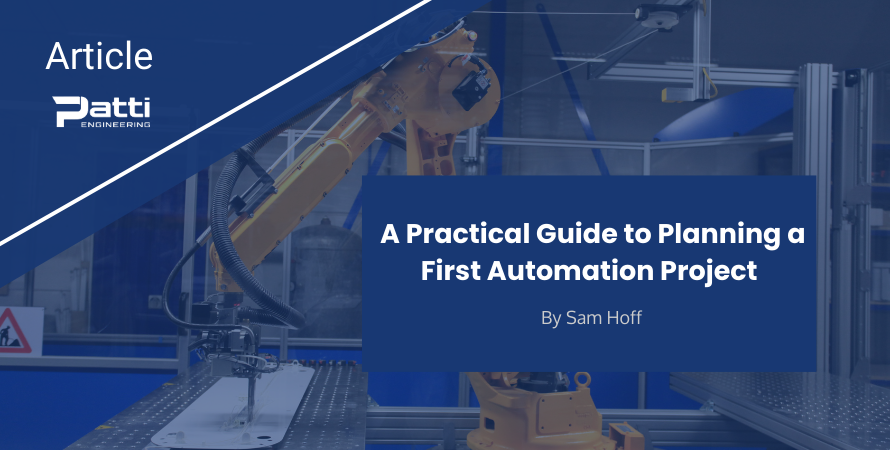
A Practical Guide to Planning a First Automation Project

This article discusses the selection, financial justification, and implementation best practices for manufacturers contemplating a first automation project to ensure long-term system success.
By Patti Engineering CEO Sam Hoff
Automation effectively addresses many production challenges, including rising labor costs and shortages, throughput limitations, product quality and process reliability issues, and operator safety concerns. While some facilities are already heavily automated, other manufacturers are considering their first investment. This article outlines how to identify suitable starting points for incorporating automation into a process, evaluate return on investment, and ensure a successful and lasting implementation. Although tailored for manufacturers new to automation, the guidance remains equally relevant for those seeking to expand existing systems.
Automation Streamlines Operations
Automating a process is a practical way to increase output, reduce operational costs, and improve product consistency. It can address some of the most persistent production challenges and pain points such as:
- Tasks that are difficult to staff consistently due to extensive training requirements.
- Bottlenecks that slow throughput.
- Processes requiring strict quality control with downstream impact.
- Operations that involve complex or high-precision steps.
- Physically demanding or repetitive work that contributes to high turnover.
- Tasks with elevated safety risks for operators.
Automation is particularly effective when applied to processes that are clearly defined, repeatable, and limiting overall throughput. It becomes especially justifiable when the costs of maintaining the manual approach, including throughput inefficiencies, quality issues, labor shortages and high operator turnover, or safety concerns remain persistent and increasing. Rather than attempting to automate everything at once, first-time adopters benefit from targeting a single high-impact challenge with a focused solution.
Calculating Automation ROI
The total cost burden of the manual process provides the foundation for evaluating the return on investment (ROI) of an automated solution. Even a rough estimate can help determine whether automation is financially justified. Key cost factors to consider include:
- Labor costs – In addition to recurring salary, consider training costs, particularly for roles with high turnover.
- Slow throughput – Factor in production losses caused by process inefficiencies or staffing shortages.
- Quality, rework, waste – Account for the cost of quality failures and any required rework or wasted materials.
- Injury and absenteeism – Consider the costs related to operator strain, fatigue, or injury, including missed work and workers’ compensation.
- Opportunity cost – Manual tasks may be occupying personnel who could add more value elsewhere if automation were implemented.
To evaluate the financial viability of the automated solution, consider the price of its initial implementation cost as well as recurring costs, including:
- Routine maintenance
- Spare parts
- Software licensing or updates
- Operator and technician training
- Service agreements for long-term support
All things considered, a common target ROI for justifying investment into an initial automated process is 18 months to three years. Automated systems that are properly maintained and periodically optimized often remain in service for 15–20 years or more, an investment that continues to deliver value beyond the initial payback period.
Selecting an Initial Automation Project
Because automated systems involve specific training, safety, and maintenance considerations, Patti Engineering recommends beginning with a single, well-defined process. A small-scale robotic cell that meets the criteria discussed earlier is often a good entry-level project. A single robot typically handles repetitive tasks well, requires minimal changes to infrastructure or layout, and can be reprogrammed for future use as needed.
When designing the solution, consider including the input from the operators currently involved in the manual task. Their feedback helps ensure the automated design addresses the full scope of the task’s requirements, and also fosters a smoother adoption of the system.
Common initial applications include:
- Robotic palletizing of bags, boxes, or other packages to improve throughput and reduce operator strain.
- Robotic machine tending to load or unload parts from CNC machines, presses, or other production equipment.
- Basic quality inspection using vision systems integrated into a robotic cell to verify important characteristics including presence/absence, orientation, or dimensions.
- Assembly tasks including inserting, fastening, or positioning parts in fixtures.
These types of systems typically address labor or ergonomic issues, have a measurable ROI, and allow for robotic equipment to be reprogrammed as needs change. Patti Engineering’s robotics guide, Common Considerations Integrating Robotics in Manufacturing, provides more information by answering common questions on the topic.
As a more detailed example, a Patti Engineering client considered a robotic palletizer to lift 30-pound bags off a conveyor and stack them on a pallet. This type of task meets the criteria for automation, including consistent inputs and outputs, repetitive sequencing, and a defined product package shape. Replacing the manual process would eliminate a physically taxing role with high turnover, and result in more consistent throughput and fewer workers’ compensation claims. Choosing between an industrial robot or a newer collaborative robot would depend on a variety of factors, including payload, speed, and proximity to operators. These are all discussed at great length in the robotics guide.
An Engineering Study Quantifies the Solution, Reduces Risk
An engineering study can significantly reduce project risk and maximize its return. Patti Engineering’s studies are conducted by experienced engineers who fully assess the current process to determine the best-fitting automated solution, including potential layouts and technologies (i.e. robotics), implementation timeline, and cost. This upfront analysis provides the manufacturer with a complete understanding of the system requirements and project scope. Patti Engineering credits the cost of the study towards the project’s implementation.
Implementation Best Practices
A successful automation project depends not only on selecting the right target process, but also on following best practices throughout implementation. The following steps minimize a project’s risk and ensure the system delivers the intended results:
- Work with an Established, Proven Partner
Manufacturers should seek a partner with a long track record of delivering automation projects, reliable technical support, and strong customer references. Experienced partners are more likely to accurately scope the project, recommend appropriate solutions, and provide ongoing support post-installation. - Develop a Functional Design Specification
The development and review of a functional design specification (FDS) ensures that both the manufacturer and the integrator are fully aligned with respect to the scope of the project before any physical or software design begins, minimizing mismatched outcomes. The FDS defines the system’s operation, how the software will function, the appearance of the screens, and how the system will interact with the broader production environment. - Select Proven, Supported Technologies
Patti Engineering recommends choosing name brand automation hardware and software. While lower-cost alternatives are available, choosing them often results in later issues with compatibility, support, and spare parts.
Plan for Continuous Improvement
Routine evaluation of the system’s performance is critical to maximizing its long-term value. A common misconception about automated solutions is that they will perform optimally immediately following installation. In reality, automated systems benefit from ongoing data collection and analysis to tune and improve their performance. Overall equipment effectiveness (OEE), a metric combining availability, performance, and quality, provides a benchmark for identifying areas for continuous improvement and maximizing automation value over time.
Best practices for monitoring and improving a system’s OEE include incorporating remotely accessible diagnostics into the system’s design. The system’s OEE performance metrics can then be regularly reviewed to identify opportunities for improvement. Patti Engineering has found that sometimes even minor changes, including how parts are presented to the system or how operators interact with it can yield measurable gains.
One long-standing Patti Engineering client has operated the same automation system for over two decades. The system has been updated twice over this time period and includes remote access and excellent built-in diagnostics. Because this client has maintained an ongoing commitment to optimization, the system remains reliable, effective, and aligned with changing production needs. Clearly, a continuous improvement approach can extend the life and impact of automation well beyond its initial investment.
Closing Remarks
Automating a process is an effective means of addressing production challenges related to labor, throughput, quality, and safety. By evaluating its costs and benefits, and following proven implementation practices, manufacturers can integrate automation into their operations to support long-term business objectives.
Related categories: Blog


